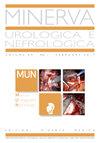PSMA PET/CT and staging high risk prostate cancer: a non-systematic review of high clinical impact literature.
Q1 Medicine
引用次数: 3
Abstract
INTRODUCTION Prostate specific membrane antigen (PSMA) positron emission tomography (PET) with computed tomography (CT) is a promising molecular imaging technique for prostate cancer (PCa). Although not yet included in international guidelines, PSMA PET/CT is commonly used in clinical practice to stage patients with newly diagnosed PCa. This review focuses on the most up-to-date literature on staging high risk prostate cancer with PSMA PET/CT. METHODS An online based literature research encompassing original studies, reviews and meta-analysis was performed in the month of November of 2019. The most relevant and impactful research was then extracted based on the expertise of the authors, with the specific focus of highlighting the clinical impact and appropriateness of PSMA PET/CT in staging PCa. RESULTS The use of PSMA PET/CT is appropriate in all high-risk patients with newly diagnosed PCa as it will often have a significant clinical impact. Although preliminary findings are promising, there is still a scarcity of data regarding the performance of PSMA PET/CT vs other modalities in defining disease within the prostate gland. There is good evidence suggesting that PSMA PET/CT may be superior to every other imaging modality in assessing loco-regional and distant metastatic disease. CONCLUSIONS PSMA PET/CT has the potential to become a gold standard in staging high risk prostate cancer, providing clinicians with accurate information on the extent of disease within the prostate and the presence of loco-regional and distant metastatic disease within a single scan.PSMA PET/CT与分期高风险前列腺癌:高临床影响文献的非系统回顾。
前列腺特异性膜抗原(PSMA)正电子发射断层扫描(PET)与计算机断层扫描(CT)是一种很有前途的前列腺癌(PCa)分子成像技术。尽管尚未纳入国际指南,但PSMA PET/CT通常用于临床实践中对新诊断的PCa患者进行分期。本文综述了最新的关于PSMA PET/CT对高危前列腺癌分期的文献。方法于2019年11月进行了一项基于在线的文献研究,包括原始研究、综述和荟萃分析。然后根据作者的专业知识提取最相关和最具影响力的研究,特别强调PSMA PET/CT在PCa分期中的临床影响和适用性。结果PSMA PET/CT在所有新诊断PCa的高危患者中都是合适的,因为它通常会产生显著的临床影响。尽管初步发现很有希望,但在确定前列腺疾病方面,PSMA PET/CT与其他模式的表现仍然缺乏数据。有充分的证据表明,PSMA PET/CT在评估局部区域和远处转移性疾病方面可能优于所有其他成像方式。结论spsma PET/CT有可能成为高风险前列腺癌分期的金标准,为临床医生提供前列腺内疾病程度的准确信息,以及单次扫描中是否存在局部区域和远处转移性疾病。
本文章由计算机程序翻译,如有差异,请以英文原文为准。
求助全文
约1分钟内获得全文
求助全文
来源期刊

Minerva Urologica E Nefrologica
UROLOGY & NEPHROLOGY-
CiteScore
5.50
自引率
0.00%
发文量
0
审稿时长
>12 weeks
期刊介绍:
The journal Minerva Urologica e Nefrologica publishes scientific papers on nephrology and urology. Manuscripts may be submitted in the form of Minerva opinion editorials, editorial comments, original articles, video illustrated articles, review articles and letters to the Editor.
 求助内容:
求助内容: 应助结果提醒方式:
应助结果提醒方式:


